Alfred Park – The Grand Old Park of Allahabad
Published by admin on
Alfred Park – The Grand Old Park of Allahabad
Written by : Nilesh Narayan,
Founder: Holy Waters India Journeys
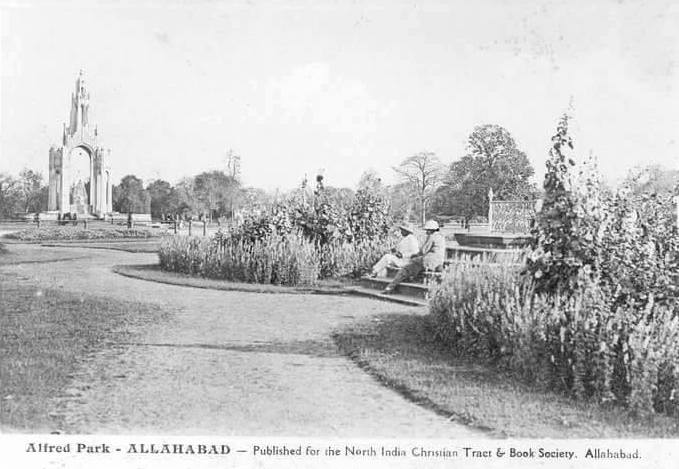
An Old Picture of Alfred Park
The design of Allahabad (now Prayagraj) is a classic colonial mix where we go around the world in search of perfect history, culture and architecture, and experiencing the one-time European attitude – influences that lie in its Victorian Styled Mansions, Vintage Cathedrals and Heritage Gardens et al. metaphoric to the power, glory and pride of the then British Empire.
The Park Legacy:
Basking in full grandeur; the city of Allahabad has two heritage gardens ‘Alfred Park and Minto Park’ which occupy an important place in the history of British India. While Alfred Park is a quintessential British park named after Queen Victoria’s second son ‘Prince Alfred’ whereas the latter (Minto Park) happens to be the original site where East India Company rule came to an end. It was here when in 1858 Lord Canning read out Queen Victoria’s famous proclamation about transferring the control of India from East India Company to the British Crown. The Viceroy’s court was setup near Minto Park and since this day the term ‘Viceroy’ came into eminence and Viceroy becoming the chief of colonial India. In 1910, the Earl of Minto (then Governor-General of India) laid a stone memorial to commemorate the transfer of power that happened 52 years ago at the very same spot. Thereby it officially came to be known as ‘Minto Park’ now Madan Mohan Malviya Park.
Alfred Park and Prince Alfred Park
Alfred Park was built in the year 1870 to mark Prince Alfred’s (Duke of Edinburgh and the second son of Queen Victoria) visit to Allahabad in 1869, amidst his voyage around the world which he started sailing from Plymouth on January 1867. Alfred Park was one among the first leisure parks to be established in India by the early British Government i.e. soon after Queen Victoria’s famous proclamation in January 1858 while taking 8 long years to complete the whole park. Interestingly Allahabad’s Alfred Park is a contemporary to Prince Alfred Park of Sydney (Australia) which also happens to be named after Prince Alfred i.e. upon his arrival in Australia in 1868 during his world tour (mentioned above) via Royal Navy’s steam frigate – HMS Galatea. It was in Sydney when Prince Alfred survived an assassination attempt at Clontarf Picnic Grounds & due to which the embarrassed authorities rushed to make amends by naming local settings after the Prince, including a park and Royal Prince Alfred Hospital in Camperdown.

Early History:
A brief glimpse to the heritage significance of Alfred Park here, offers a thrilling opportunity to delve into park’s fascinating history and reflecting a glance of how the park came into its real existence and ultimately becoming the ‘Theatre of British Glory’.
Alfred Park also famous as Company Bagh was designed to give pleasure to the most cultured eyes of the then lords and ladies and had characteristics similar to Royal – Victorian parks of England adding up to what people perceive as the typical British park. The quintessentially British park in Allahabad is spread across an area of about 133 acres and has a colonial legacy of more than 150 years.
Situated at just a stone throw away from the historic Muir Central College of Allahabad University (Founded in 1872) ‘Company Bagh’ is surrounded by the erstwhile British neighborhoods of Georgetown, Tagoretown and Civil Lines or Cannington. The locality Cannington here is named after Earl Canning, the first ever Viceroy of India (1858 – 1862) where during the early period of its development was referred to as the White Town of the city as it was predominated by the British people and a very few Indians were allowed. Post Independence many prosperous Indians moved to the newly built European enclave. The Civil Lines, contains an interesting story – variety of colonial architecture and as of today the neighborhood is still world famous for its heritage bungalows.
After suppressing the Indian Rebellion of 1857 the British Rulers came up with a well calculated and strategic plan of building Allahabad as a central administrative seat for the British high command. Allahabad became the capital of the United Provinces from 1902 to 1920 and was declared the capital city of the country for one day i.e. on the day Queen Victoria’s proclamation in 1858. This was the time when Country’s largest town-planning project (Civil Lines) was being carried out here in Allahabad that is to say before the establishment of New Delhi, resulting in the large scale infrastructural developments of the city such as:
- Setting up of new townships namely – Cannington, Georgetown, Lukergunj, Johnstongunj, Colonelgunj, Mumfordgunj etc.
- Construction of principal roads: Queen’s Road, Elgin Road, Clive Road, Hastings Road, Thornhill road…
- Establishments of new Civic Buildings, Boulevards, Churches, Clubs & most importantly Parks to suit the fine tastes of then colonial elites where massive repressions, mass murders and destructions of defiant villages led to the advancement of Allahabad City as a metropolis of the great colonial power.
In 1858, once a home to thousands of village dwellers ‘Company Bagh’ was carved out on the ruins of two erstwhile villages: Samdabad and Sultanpur Bhava that were burnt down in the holocaust of 1857. The two villages were severely deserted after General James Neill, the infamous “Butcher of Allahabad” and Major General Henry Havelock quashed the uprising while hanging most of the villagers (Meo or Mewati community) to death. ‘Neill’ according to one of his officers, allowed his soldiers to kill the native people without due process and burn them from their houses.

“Butcher of Allahabad”
During the heyday of the 1800s Alfred Park became an important site of leisure for then colonial administrators while it also served as the venue for official ceremonies which were often followed by musical performances of the police orchestra. The grandeur of the park was once marked by huge statues of King George the fifth and Queen Victoria (Victoria Memorial) that were installed within the leafy richness of the park. The white sculpture of the Empress was designed by famous British artist ‘George Edward Wade’ who designed two similar marble statues of which the first one (originally designed for Allahabad) was installed in Colombo (Sri Lanka) in the year 1897 and the other one was installed in Allahabad. Interestingly it was during the same period when similar versions (enthroned) of Queen Victoria statues were commissioned in Hong Kong, Kimberley (South Africa) and other one – time imperial cities of the British Empire.
This was the period that witnessed the creation of England’s most famous public parks such as: Liverpool’s Sefton Park in 1872, Birmingham’s Handsworth Victoria Park in 1880s and Sheffield’s Endcliffe Park in 1887 (the Endcliffe Park in South Yorkshire was opened to honor the jubilee of Queen Victoria). People were just captivated by the scintillating surroundings and high standard maintenance of the Company Garden in Allahabad.
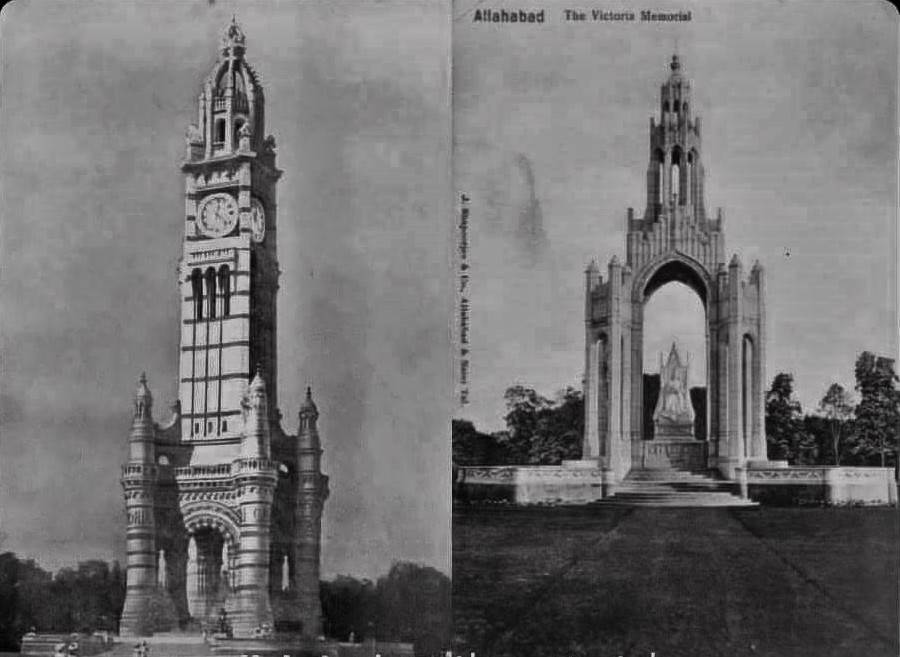 The first proposed design of Victoria Memorial (left) in Alfred Park and
The first proposed design of Victoria Memorial (left) in Alfred Park and
Queen Victoria Statute (right) by George Edward Wade
PC: Allahabad Heritage Society
‘Heritage Sites in Alfred Park’
The Chandra Shekhar Azad Memorial
A section of the Park is named after Chandra Shekhar Azad, a noted Indian freedom fighter who sacrificed his life here during the Indian independence movement in 1931. It is the same place where the famous encounter between the British Police and Indian revolutionary took place. A statue of Azad has been erected at the very spot where he died. “He shot himself after being surrounded by the police and left with no option of escape after the ammunition was finished. It is said that he used to keep a bullet to kill himself in the event of being caught by the British”. Azad’s Colt Pistol, a .32 bore semi-automatic pocket hammerless 1903 model is on display at the Allahabad Museum.
Chandra Shekhar Azad Memorial (left) and Azad’s Colt Pistol (right) in Allahabad Museum,
In the backdrop a rare picture of Azad’s lying body on the ground at the Alfred park with British police officials surrounding him
Allahabad Museum
Pre 1947
Established in 1931, Allahabad Museum is a museum of international importance and is one among the four national level museums that come under the direct control of Ministry of Culture, Government of India. The history of the museum dates back to 1863 when the Board of Revenue requested then North – Western provincial Government to establish a museum and a public library as a result of which a beautiful building was inaugurated in 1878 with contributions from then Lieutenant Governor Sir William Muir and the Maharaja of Vizianagaram HM Gajapati Raju III. In 1931 a new museum was opened in the Municipal Building of Allahabad under the direct initiation of Pt. Jawaharlal Nehru (then president of the Municipal Board) as the earlier one was closed down due to unforeseen reasons in 1881. This was the time when Allahabad Museum acquired some of the finest art collections and masterworks of the most eminent personalities from Bengal School Arts such as: Asit Kumar Haldar, Abanindranath Tagore, Gaganendranath Tagore, Sudhir Ranjan Khastgir, Anagarik Govinda, Jamini Roy and Nand Lal Bose…
Post 1947
The proliferation of collectibles and limited space within the house made it difficult to manage and organize the museum in a systematic way so it was decided to reallocate the entire museum to a whole new premises i.e. in the Alfred Park. Consequently the stone was laid by Pt. Nehru on 14th December 1947 to mark the founding of the new building. The museum was finally opened in 1954. Today the Allahabad Museum is a state of the art research facility for Archaeologists, Conservators, Historians and Renowned Scholars from around the world. The museum uses its own Solar Power System being country’s very first museum to become self-reliant in power generation. The Governor of Uttar Pradesh serves as an ex officio Chairman of the Allahabad Museum.
Collections:
- The Allahabad Museum has 16 dedicated galleries of artifacts related to Art, History, Archaeology, Architecture and Literature that ranges from 40,000 BCE to 21st Century.
- The museum has the largest Terracotta collection in the world.
- Allahabad Museum has 19 exclusive Himalayan paintings of Nicholas Roerich in its modern paintings collection. Roerich was a Russian painter, philosopher and archaeologist and a renowned personality who earned several nominations for the Nobel Peace Prize. There are 10 Roerich Halls all over the world (including Roerich Museum in New York) and Allahabad Museum is one among them.
- The Gandhi Smriti Vahan a 47-Model V-8 Ford Truck which was used in the procession to immerse Gandhi’s ashes at the Holy Sangam on February 12, 1948. The museum houses 2 special galleries devoted to Mahatma Gandhi and Jawaharlal Nehru.
- The museum’s library has a huge collection of 25,000 books, including rare – translated works of ancient Roman and Greek scholars.
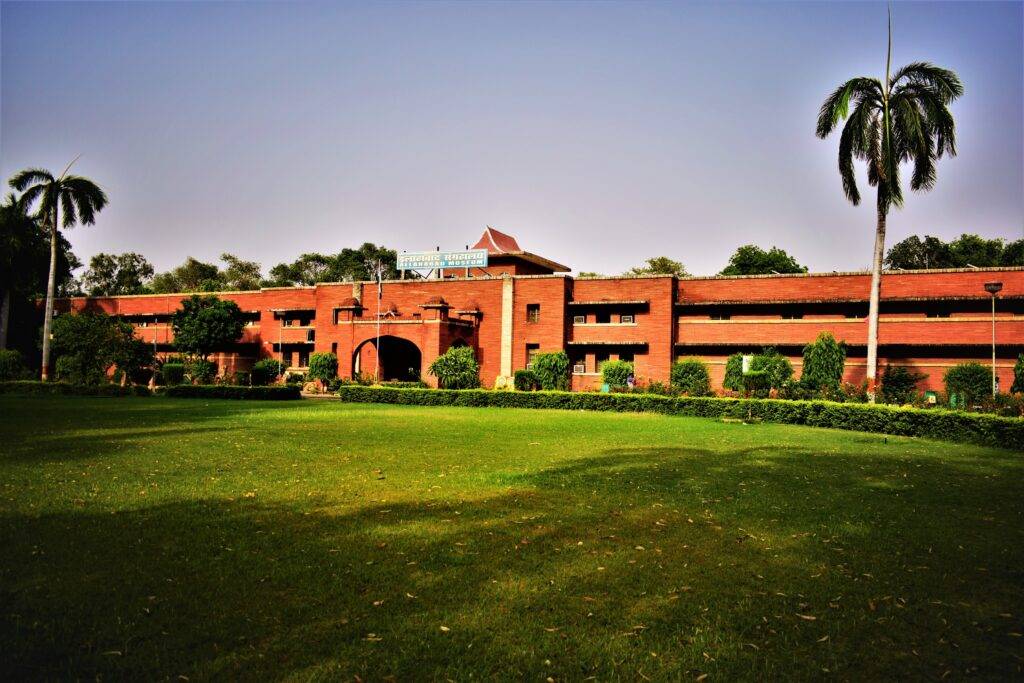
Victoria Memorial
The park has an imposing structure within its center. This is a tall canopy made of Italian limestone that once sheltered a huge one piece marble statue of enthroned Queen Victoria designed by George Edward Wade, presently in State Museum – Lucknow. The memorial was unveiled in 1906 by James Digges La Touche, An Irish Civil Servant who was then Lieutenant Governor of the United Provinces i.e. from 1902 – 1906. The Victoria memorial in Alfred Park is a classic example of English Baroque style of architecture that flourished in England during the late 17th and early 18th Century. The structure is nothing but an excellent piece of compliment to the verdure of its own garden.

The Police Bandstand
The Police Bandstand in Alfred Park is a Victorian era structure, a raised platform located at the very center of the garden. During the British raj the park was considered to be the most ideal venue to host official ceremonies and customary practices that were often followed by musical performances of the Police band. The round podium was perfectly designed and was open enough to accommodate performers & the accouterments giving a panoramic of the event to the distinguished attendees. The bandstand here is one among the earliest bandstands that were raised in UK and its colonies during the mid 19th century. The first Bandstands were built around 1861 in Royal Horticultural Society Gardens (U.K.)

Thornhill Mayne Memorial a.k.a. Allahabad Public Library
Established in 1864, Mayne Memorial is a Public Library that initially served as the house of Legislative Assembly of the United Provinces. Thorhill Mayne is a memorial dedicated to the friendship of Commissioner Cuthbert Bensley Thornhill & F.O. Mayne the then Collector of Allahabad. On 8 January 1887 the first ever meeting of the Legislative Council for the North Western Provinces – Awadh was held in this very building while It was also for the very first time under the British rule that views of some noted Indian members namely; Rai Bahadur Durga Prasad, Pt. Ayodhya Nath and Sir Syed Ahmed Khan were taken into account in framing of Rules and Conduct of the state legislature under the chairmanship of the then Lt. Governor and GE Nox who presided as the first secretary of the council.
Thornhill Memorial hall famous for its one of a kind Scottish Baronial architecture or Scots Baronial (Only in Asia) the building is designed by eminent British architect Richard Roskell Bayne. The design of the Public Library is inspired from the 16th century private mansions of Edinburgh (Scotland); interestingly the same architecture has been the chief inspiration behind the creation of Hogwarts Castle in the Harry Potter films. This as the author J.K. Rowling moved to Edinburgh amidst the writing of the series.
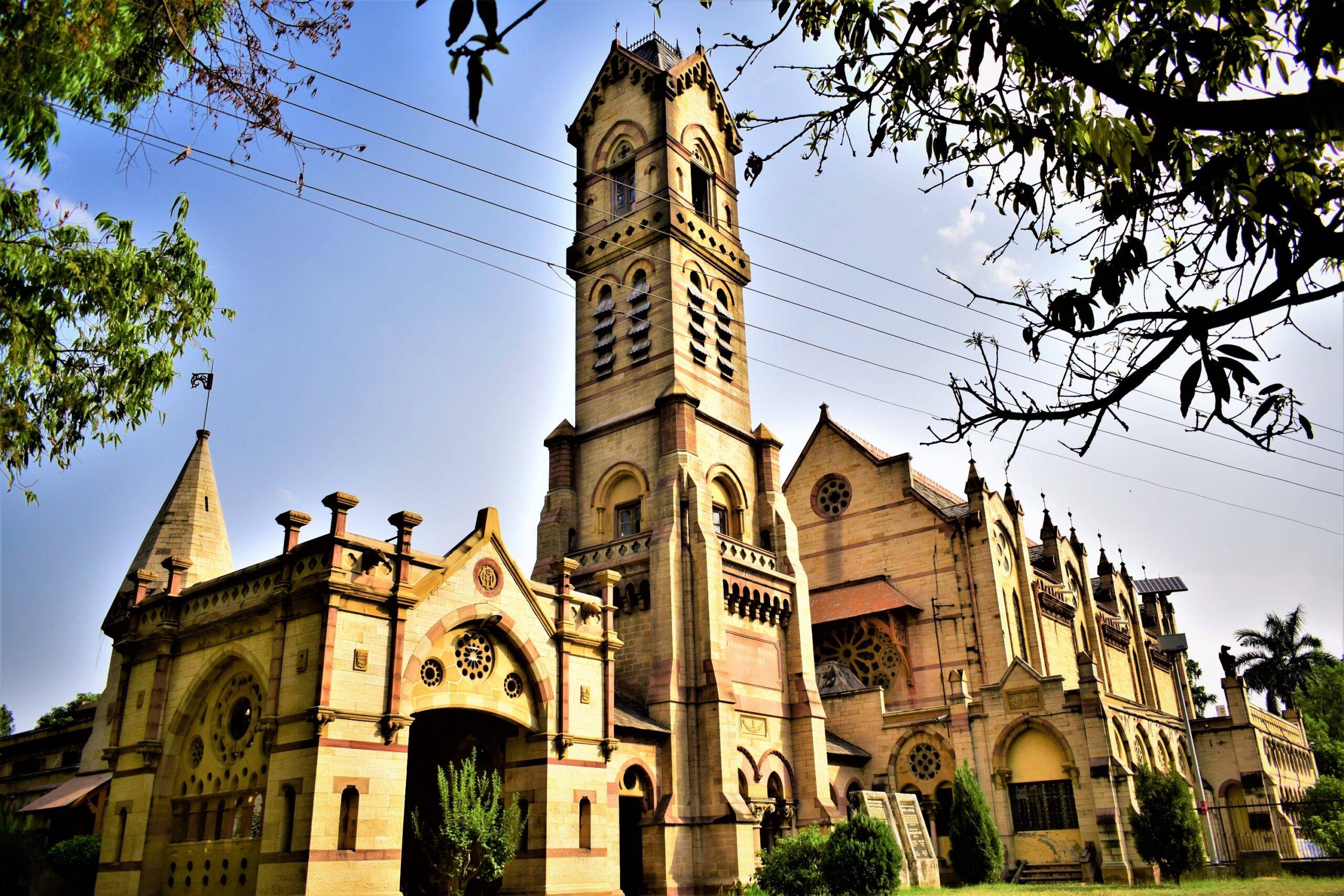
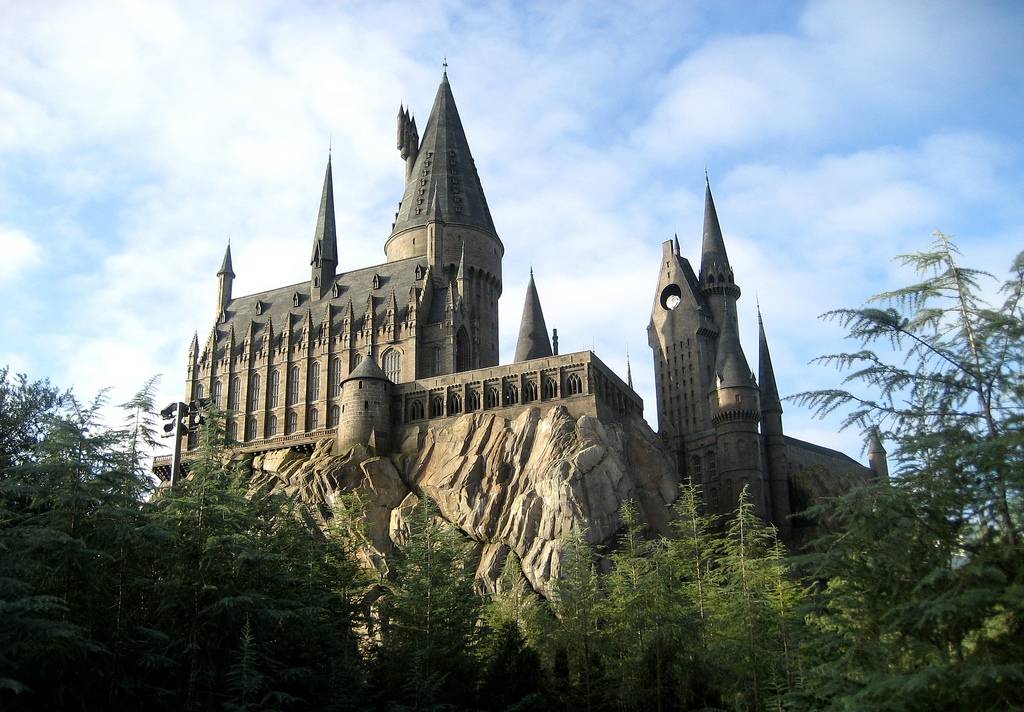
The entire structure of the memorial has been built using cream coloured Mirzapur sandstone and is beautifully ornamented with Red – Black Granite Pillars, Gothic Pointed Arches, Arcaded Cloisters, Finials and other decorative features atop towers and spires.
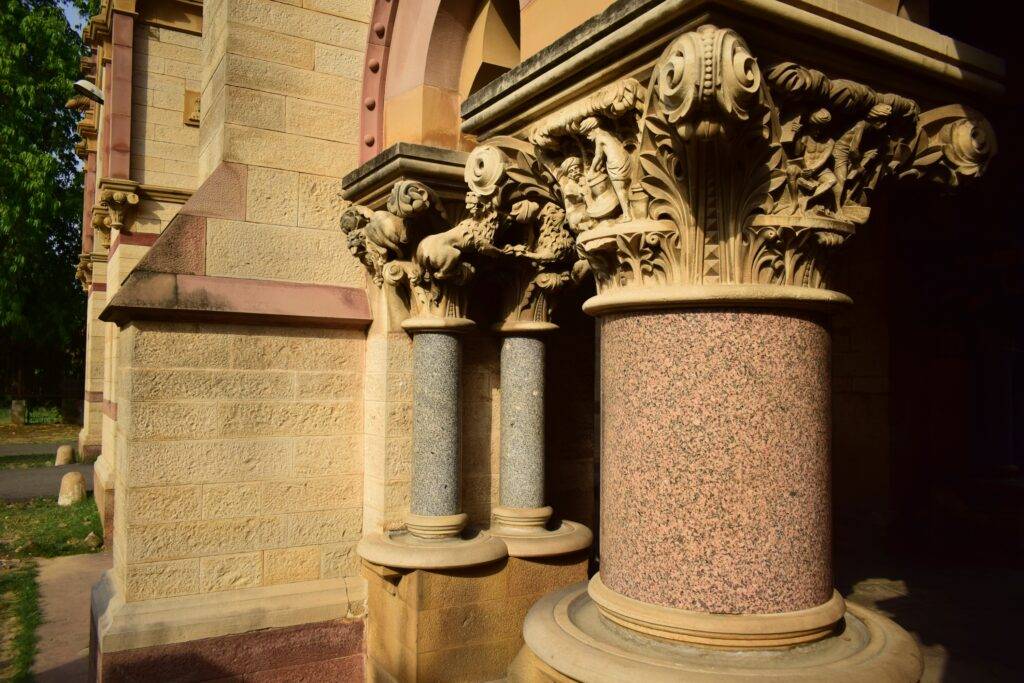
Thornhill Memorial is also a contemporary of Greenock Sheriff Court of Scotland. Designed in 1867 Greenock Court Building has been described as one of the finest specimen of the Scottish Baronial Architecture from the 19th Century while it comes for no surprise for us that our ‘Thornhill Mayne Memorial’ of Allahabad stands firm to the very architectural philosophy and greatness of Greenock Court building perhaps more a challenging phenomenon…
At present the library is one among the oldest and biggest libraries of the country and has an approximate collection of 125,000 books that includes Rare Manuscripts, Parliamentary Papers from the 19th Century, and Government Gazettes etc.
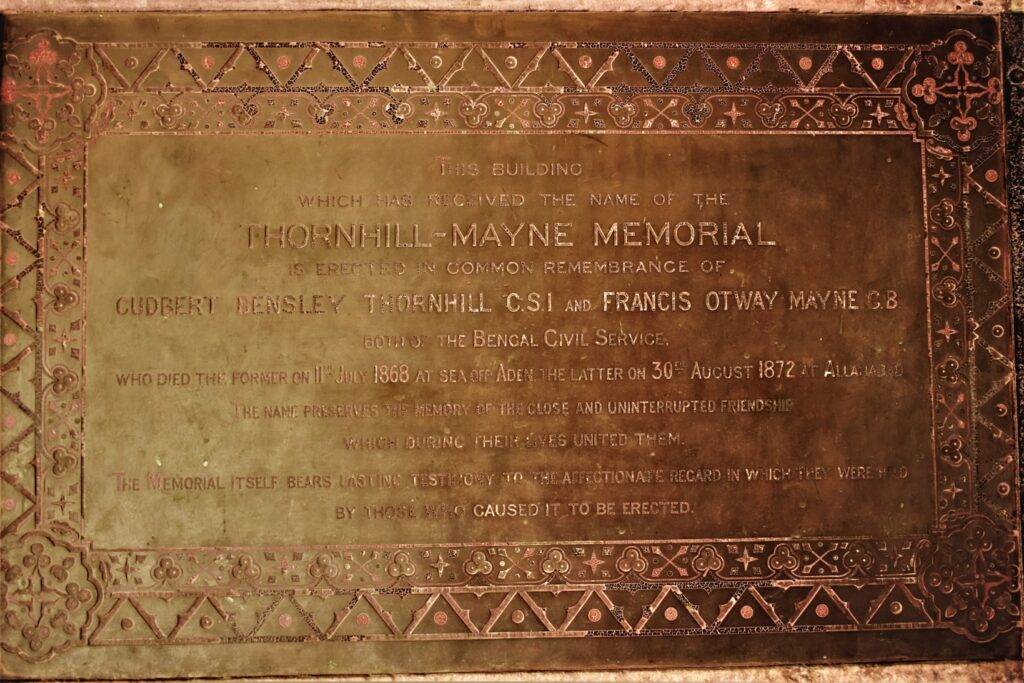
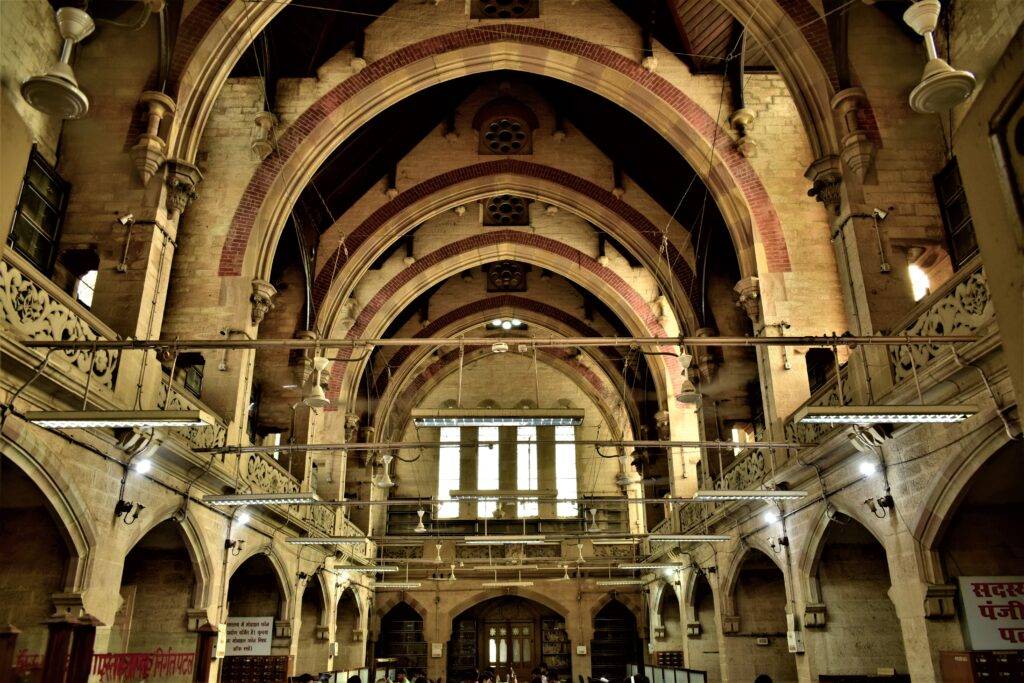
The Gymkhana Club
The legendary park has had all the essentials of then English vanity including one Gentleman’s Club or The Gymkhana Club in the heart of Alfred Park. Principally ‘Gymkhana’ is an Anglo Indian term for Sports Club. Sports was the most favored leisure activity during the 19th Century British rule where Cricket and Polo were highly popular among the high-ranked officials. The Allahabad Gymkhana Club was a well-liked place; for Judges of the High Court, Eminent Lawyers and affluent traders who met with great ease and camaraderie. Bombay Gymkhana, Colombo Gymkhana, Nairobi Gymkhana Club and Karachi Gymkhana Club are some of the best famous Gymkhana clubs.
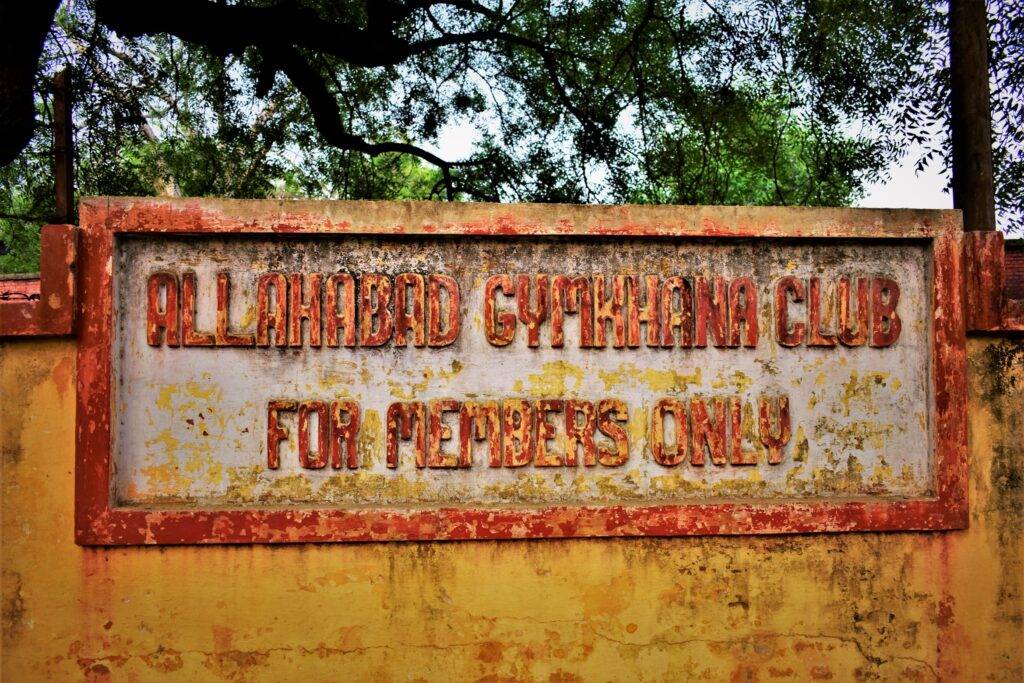
Tennis tales & Cricket chronicles of Allahabad Gymkhana Club
Tennis in India is a 120 year old story. The time of 1932 much before India joining the ‘elites’ of the cricketing world and it was the British who made tennis a popular sport here in this part of the world. It was in the year 1910 when all India tennis championship was started in Allahabad at the Gymkhana Club and was the first ever national tennis championship to be held in the country. Championships in Allahabad were held for years: 1910 – 1938, 1944, 1946 – 1949, 1950 – 1951 that hosted the legends such as: Roderich Menzel (Czechoslovakia), Jaroslav Drobný (Egypt), Franjo Kukuljević (Yugoslavia), Felicisimo Ampon (Philippines), Sven Davidson (Sweden), Josip Palada (Yugoslavia), Ladislav Hecht (Austria-Hungary), Sven Lennart Bergelin (Sweden), Sumant Misra (The Grandfather of Indian Tennis) and Mohd Saleem who in 1922 won the All India Championship (Allahabad) defeating Australian ace Lewis-Barclay in the sets of 3. Saleem was the uncle of Manzur Qadir (Foreign Minister under Ayub Khan’s Govt. of Pakistan).
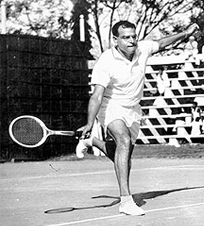
“The Grandfather of Indian Tennis”
Tourneys such as; Punjab lawn tennis championship (1885), Bengal lawn tennis championship (1887) and all India tennis championships at Allahabad (1910) were regularly organized providing ranking to the national players which was a great facility before they set out for Wimbledon and Davis Cup championships.
In 1919 Allahabad, it was an iconic moment when Mr. Nagu became the first Indian to win the trophy in the all India tennis championship (singles title) at the age when the game was largely dominated by the British officials/players who originally brought the sport in India.
It is a widely held view among the locals that Gymkhana Club of Allahabad once had 40 Lawns Tennis Courts (Grass Courts) which was highest in the country.
West Indies Tour of India, 1948-49
The stadium today (now Madan Mohan Malviya Stadium) was once used to be the cricket stand of the prestigious Gymkhana Club. A historic site that once celebrated the glorious victory of India East Zone over West Indies in the year 1948 – 49. A remarkable chapter in India’s cricketing history with Indian side in line with PE Palia (Captain), Pankaj Roy, Surjuram Girdhari and Sarobindu Nath Banerjee, who’ve hit the final runs on a matting wicket against the legendry Indies team that had guns like John Goddard (Captain), Sir Clyde Walcott, Gerry Gomez and Jeffrey Stollmeyer etc. It is worth mentioning that Indies star player ‘Sir Everton Weekes’ (West Indies Cricket’s “Founding Father”) was also one among the 16 member test tour party that arrived in Allahabad.
The 3 day test match was inaugurated by Mrs Sarojni Naidu the then U.P. Governor and happens to be the only match of the series that West Indians had lost by 10 wickets. Out of the ordinary it is also interesting to know that Goddard (Captain) went for a dip at the holy Sangam after the match.
Remnants of 1857 Holocaust – the Mosque, Tombs & Cannons
The aftermath of Indian Rebellion of 1857 resulted in repressions of natives, mass slaughter, genocide and destructions of defiant villages. The new Government led a vigorous programme of building Allahabad as a strategic seat of the new central power. It was the time when large scale development was observed in Allahabad including establishments of new Civic Buildings, Churches, Clubs and most importantly Parks or Imperial Gardens to suit the flavor of then colonial elite. The Alfred Park that was once a home of two erstwhile villages: Samdabad and Sultanpur Bhava witnessed one of the most severe holocaust of its times. The dwellers (the Meo Community also Muslim Rajput Community) of these two villages were executed for their alleged alliance with the Indian Rebels and those who survived moved to Khuldabad area.
The Remnants:
The whole area was razed to death. Today the Park now exists with then ruins of the 1857 holocaust i.e. a demolished mosque, a wrecked gateway, the graves of the dead and the evil canons of destruction. The history’s horrific character can easily be traced while visiting to the site of the episode; where lies a fallen dome right beside the broken arch that was busted by the cannon shot. At the site one would also get the glimpse of shattered walls and a huge Mughal style gateway (ruined) to the one-time mosque. Hundreds of graves are scattered around the park area as it took several days for the carts to carry the carcasses of the people who died in the carnage of 1857 while remaining were buried in their respective villages of ‘Samdabad’ and ‘Sultanpur Bhava’.
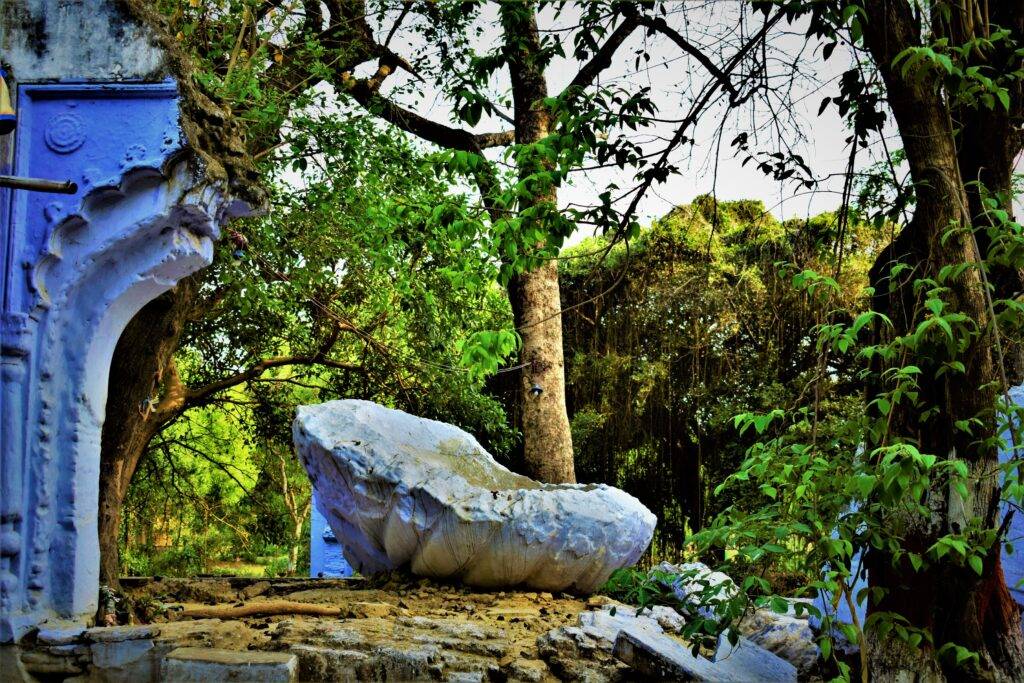
“Blowing from the Gun” was the method that was used by the British troops to execute the rebels of 1857 insurrection. The guns used in the massacre are now centerpieces of attraction to the visitors of the park.

Grave of St. Richarduddin
Among hundreds of graves that lie mysteriously in the greens of Company Bagh, one is of ‘Richard Sahib’ a.k.a. ‘St Richarduddin’. Originally it is George Richard Watkins a British soldier who was killed in the Indian Rebellion of 1857 but in some circles of the city it is believed that Richard Sahib was an English Gentleman who decided to lead an austere life acquired spirituality and ultimately went on becoming a revered saint. At present the grave is fenced in a steel enclosure with a crown cross at the top. The tomb is highly venerated as ‘Mazaar’ (grave of the holy man) by the locals who often come and mark their presence by paying regular homage to the great soul.
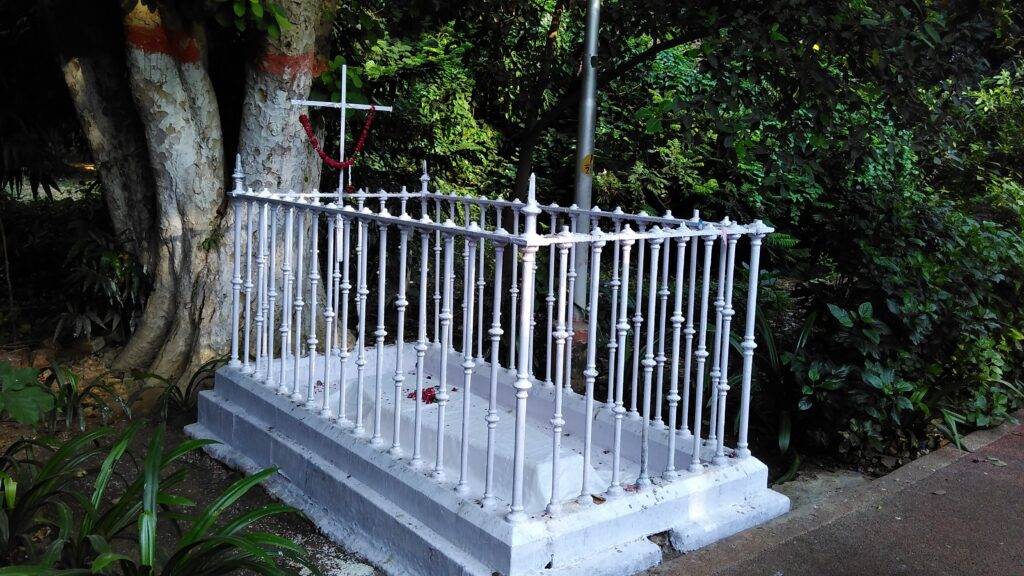
Whose epitaph says :-
Sacred to the memory of George Richard Watkins,
Quarter-master Sergeant of the 6th Regiment, who was killed on 6th June 1857.
Aged 30 years 1 month and 21 days.
The Kalpavriksha
Inside Company bagh we have this mighty Kalpavriksha tree situated at just 2 km from the epic ‘Bhardwaj Ashram’of sage Bhardwaj, the author of Ayurveda. (The ancient Bhardwaj Ashram in Prayagraj gets a mention in Tulsi Ramayana where one can witness the Charan Paduka or the Footprints of Sri Ram there to commemorate his visit)
The Kalpavriksha tree in Company Bagh is the ancient Parijat tree notably known as the Baobab tree or ‘Adansonia Digitata’ which is its scientific name. As per popular Hindu belief this is a wish granting tree which has numerous legends associated with it. According to earliest sources the Kalpavriksha is a divine tree that is said to be originated during the Samudra Manthan or Churning of the Milky Ocean along with ‘Amrita’ or the Nectar (that fell into Triveni Sangam) and the sacred ‘Kamadhenu’ cow. The tree bears beautiful white flowers with five petals that blossom occasionally. Reasonably it is rare to find Baobab tree in the tropical lands of India as the tree is an indigenous variety of Sub – Sahara Africa and believed to have been brought to India by Arab slaves and soldiers, hundreds of years ago. Though uncommon but yes Prayagraj has 2 Kalpavriksha trees and one of them is situated in Jhunsi near Triveni Sangam.
Mythology:
The ‘Kalpavriksha’ is believed to be the birthplace of ‘Sirius’ a.k.a ‘Dog Star’ which is the brightest star in the sky and is a valuable subject of Jain, Buddhist and Hindu religious belief.
In Hinduism:
It is said that the daughter of Lord Shiva ‘Ashokasundari’ was born out of Kalpavriksha and also Lord Krishna brought this tree to gratify her beloved wife ‘Rukmini’.
In Buddhism:
The Kalpavriksha is dated to the Dharmachakra period of Buddhism in addition to this goddess ‘Shramana’ is seen to be holding a jeweled branch of the Kalpavriksha tree in her left hand.
In Jainism:
According to Jain cosmology there are about ten of these divine trees in this entire universe that fulfill ten different wishes of wishers.
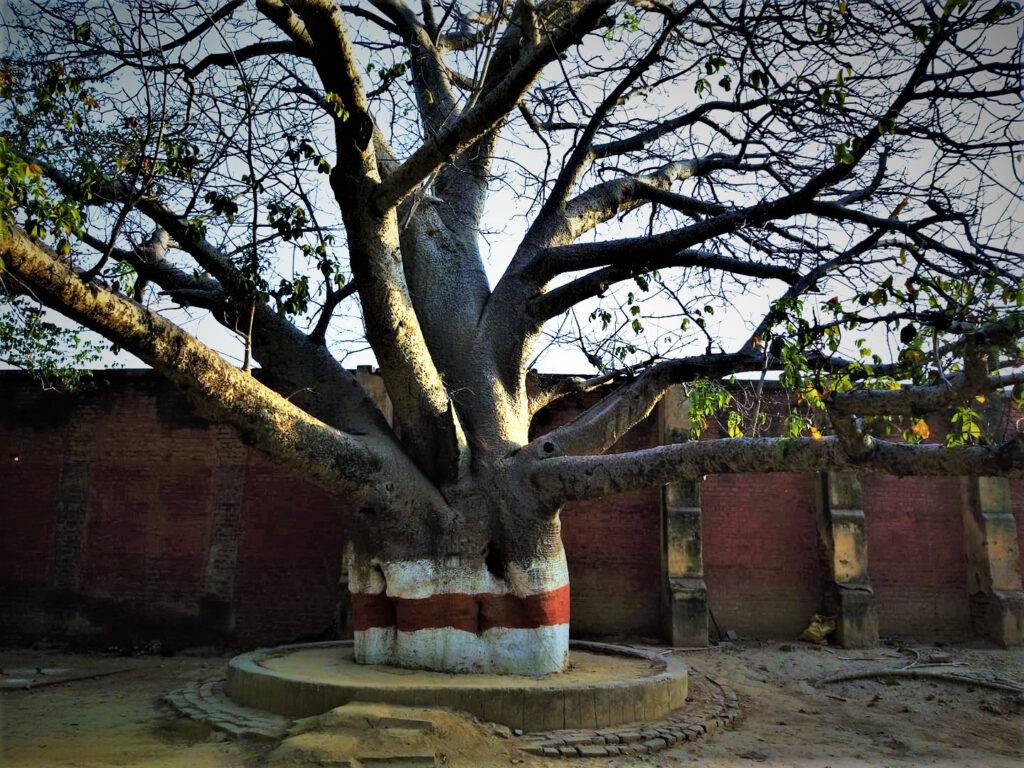
PC: Abha Singh
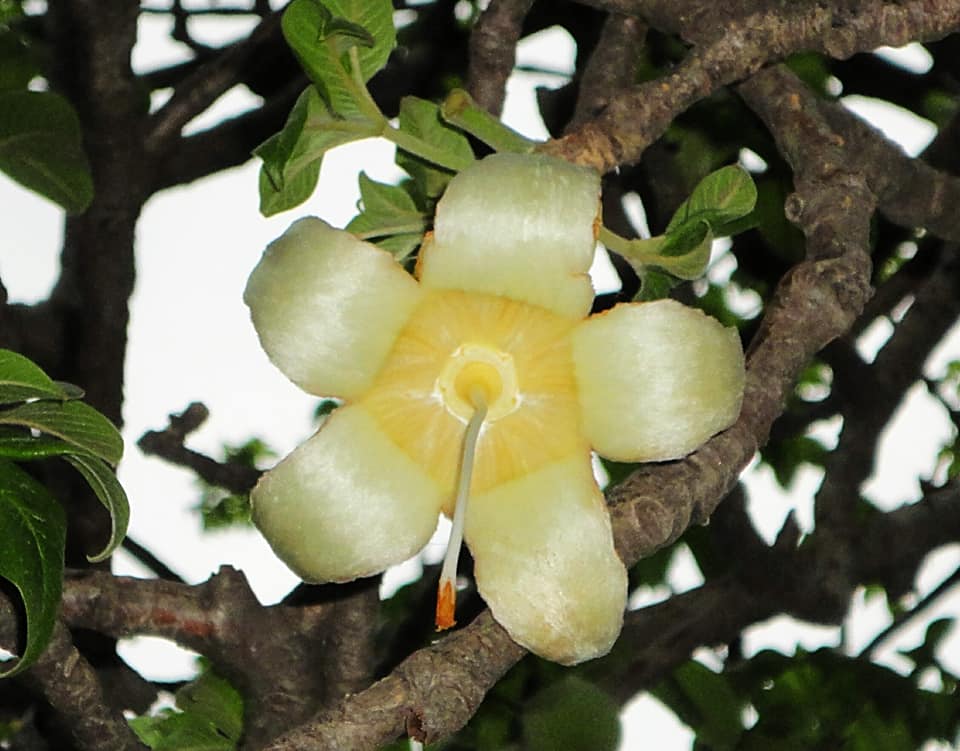
PC: Ajai Gopal
Ganganath Jha Research Institute
The institute was founded in 1943 and has a splendid campus inside the Alfred Park. It is named after ‘Sir Ganganath Jha’ who was one of the most eminent scholars of Sanskrit and Buddhist Philosophy in the early 1900’s. Ganganath Jha is the premier institute for oriental studies and Sanskrit philosophy.
About Sanskrit: It is regarded as the oldest Indo-European language and its origin can be traced back from second millennium BCE. There are much vocabularies of Malaysian, Indonesian and Philippine languages that have derived from Ancient Sanskrit Language.
Other Highlights of Alfred Park
There are also some very important heritage and recreational sites in the huge surroundings of the Alfred Park such as: Women’s Club, a state of the art sports arena known as the Madan Mohan Malviya Sports Stadium, a Garden Center or Plant Nursery, an Outdoor Yoga Centre and a colonial era music institute commonly recognized as Prayag Sangeet Samiti, established in 1925 the school was built as a cultural highpoint during the British Raj. The park has very recently witnessed the installation of a decommissioned ‘MIG 21’ Fighter Aircraft of the Indian Air Force a kind move to motivate the youths to join IAF. The site is a dedicated ‘Selfie Point’.
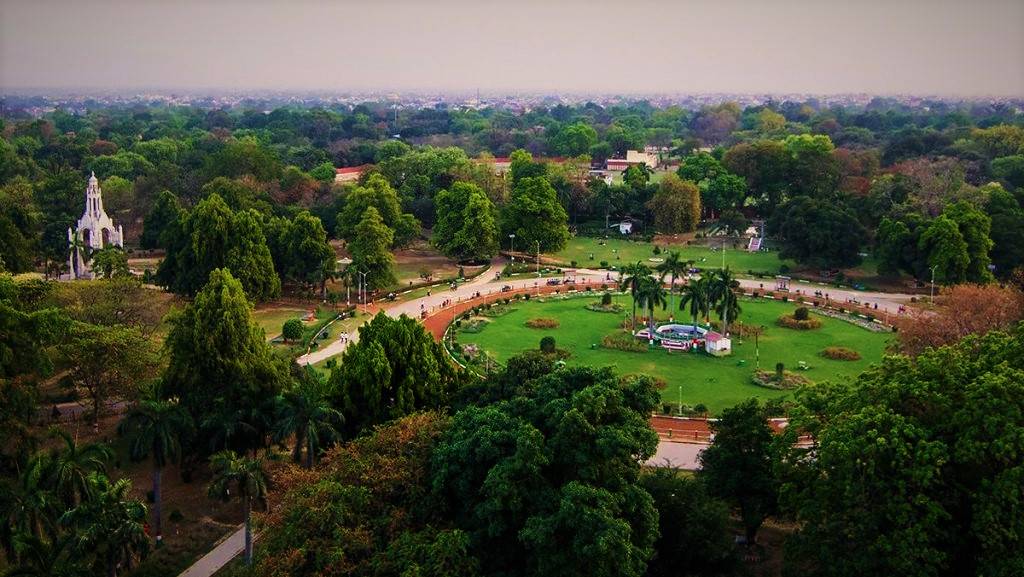
A Bird’s Eye View at Alfred Park
Written by : Nilesh Narayan,
Founder: Holy Waters India Journeys

The design of Allahabad (now Prayagraj) is a classic colonial mix where we go around the world in search of perfect history, culture and architecture, and experiencing the one-time European attitude – influences that lie in its Victorian Styled Mansions, Vintage Cathedrals and Heritage Gardens et al. metaphoric to the power, glory and pride of the then British Empire.
The Park Legacy:
Basking in full grandeur; the city of Allahabad has two heritage gardens ‘Alfred Park and Minto Park’ which occupy an important place in the history of British India. While Alfred Park is a quintessential British park named after Queen Victoria’s second son ‘Prince Alfred’ whereas the latter (Minto Park) happens to be the original site where East India Company rule came to an end. It was here when in 1858 Lord Canning read out Queen Victoria’s famous proclamation about transferring the control of India from East India Company to the British Crown. The Viceroy’s court was setup near Minto Park and since this day the term ‘Viceroy’ came into eminence and Viceroy becoming the chief of colonial India. In 1910, the Earl of Minto (then Governor-General of India) laid a stone memorial to commemorate the transfer of power that happened 52 years ago at the very same spot. Thereby it officially came to be known as ‘Minto Park’ now Madan Mohan Malviya Park.
The Proclamation Pillar in Minto Park (right), Allahabad
Alfred Park and Prince Alfred Park:
Alfred Park was built in the year 1870 to mark Prince Alfred’s (Duke of Edinburgh and the second son of Queen Victoria) visit to Allahabad in 1869, amidst his voyage around the world which he started sailing from Plymouth on January 1867. Alfred Park was one among the first leisure parks to be established in India by the early British Government i.e. soon after Queen Victoria’s famous proclamation in January 1858 while taking 8 long years to complete the whole park. Interestingly Allahabad’s Alfred Park is a contemporary to Prince Alfred Park of Sydney (Australia) which also happens to be named after Prince Alfred i.e. upon his arrival in Australia in 1868 during his world tour (mentioned above) via Royal Navy’s steam frigate – HMS Galatea. It was in Sydney when Prince Alfred survived an assassination attempt at Clontarf Picnic Grounds & due to which the embarrassed authorities rushed to make amends by naming local settings after the Prince, including a park and Royal Prince Alfred Hospital in Camperdown.

Early History:
A brief glimpse to the history of this park here offers a thrilling opportunity to delve into park’s fascinating history and reflecting a glance of how the park came into its real existence and ultimately becoming the ‘Theatre of British Glory’.
Alfred Park also famous as Company Bagh was designed to give pleasure to the most cultured eyes of the then lords and ladies and had characteristics similar to Royal – Victorian parks of England adding up to what people perceive as the typical British park. The quintessentially British park in Allahabad is spread across an area of about 133 acres and has a colonial legacy of more than 150 years.
Situated at just a stone throw away from the historic Muir Central College of Allahabad University (Founded in 1872) ‘Company Bagh’ is surrounded by the erstwhile British neighborhoods of Georgetown, Tagoretown and Civil Lines or Cannington. The locality Cannington here is named after Earl Canning, the first ever Viceroy of India (1858 – 1862) where during the early period of its development was referred to as the White Town of the city as it was predominated by the British people and a very few Indians were allowed. Post Independence many prosperous Indians moved to the newly built European enclave. The Civil Lines, here contains an interesting story – variety of colonial architecture and as of today the neighborhood is still world famous for its heritage bungalows.
After suppressing the Indian Rebellion of 1857 the British Rulers came up with a well calculated and strategic plan of building Allahabad as a central administrative seat for the British high command. Allahabad became the capital of the United Provinces from 1902 to 1920 and was declared the capital city of the country for one day i.e. on the day Queen Victoria’s proclamation in 1858. This was the time when Country’s largest town-planning project (Civil Lines) was being carried out here in Allahabad that is to say before the establishment of New Delhi, resulting in the large scale infrastructural developments of the city such as:
- Setting up of new townships namely – Cannington, Georgetown, Lukergunj, Johnstongunj, Colonelgunj, Mumfordgunj etc.
- Construction of principal roads: Queen’s Road, Elgin Road, Clive Road, Hastings Road, Thornhill road…
- Establishments of new Civic Buildings, Boulevards, Churches, Clubs & most importantly Parks to suit the fine tastes of then colonial elites where massive repressions, mass murders and destructions of defiant villages led to the advancement of Allahabad City as a metropolis of the great colonial power.
In 1858, once a home to thousands of village dwellers ‘Company Bagh’ was carved out on the ruins of two erstwhile villages: Samdabad and Sultanpur Bhava that were burnt down in the holocaust of 1857. The two villages were severely deserted after General James Neill, the infamous “Butcher of Allahabad” and Major General Henry Havelock quashed the uprising while hanging most of the villagers (Meo or Mewati community) to death. ‘Neill’ according to one of his officers, allowed his soldiers to kill the native people without due process and burn them from their houses.

“Butcher of Allahabad”
During the heyday of the 1800s Alfred Park became an important site of leisure for then colonial administrators while it also served as the venue for official ceremonies which were often followed by musical performances of the police orchestra. The grandeur of the park was once marked by huge statues of King George the fifth and Queen Victoria (Victoria Memorial) that were installed within the leafy richness of the park. The white sculpture of the Empress was designed by famous British artist ‘George Edward Wade’ who designed two similar marble statues of which the first one (originally designed for Allahabad) was installed in Colombo (Sri Lanka) in the year 1897 and the other one was installed in Allahabad. Interestingly it was during the same period when similar versions (enthroned) of Queen Victoria statues were commissioned in Hong Kong, Kimberley (South Africa) and other one- time imperial cities of the British Empire.
This was the period that witnessed the creation of England’s most famous public parks such as: Liverpool’s Sefton Park in 1872, Birmingham’s Handsworth Victoria Park in 1880s and Sheffield’s Endcliffe Park in 1887 (the Endcliffe Park in South Yorkshire was opened to honor the jubilee of Queen Victoria). People were just captivated by the scintillating surroundings and high standard maintenance of the Company Garden in Allahabad.

Queen Victoria Statute (right) by George Edward Wade
PC: Allahabad Heritage Society
‘Heritage Sites in Alfred Park’
The Chandra Shekhar Azad Memorial
A section of the Park is named after Chandra Shekhar Azad, a noted Indian freedom fighter who sacrificed his life here during the Indian independence movement in 1931. It is the same place where the famous encounter between the British Police and Indian revolutionary took place. A statue of Azad has been erected at the very spot where he died. “He shot himself after being surrounded by the police and left with no option of escape after the ammunition was finished. It is said that he used to keep a bullet to kill himself in the event of being caught by the British”. Azad’s Colt Pistol, a .32 bore semi-automatic pocket hammerless 1903 model is on display at the Allahabad Museum.
Chandra Shekhar Azad Memorial (left) and Azad’s Colt Pistol (right) in Allahabad Museum,
In the backdrop a rare picture of Azad’s lying body on the ground at the Alfred park with British police officials surrounding him
Allahabad Museum
Pre 1947
Established in 1931, Allahabad Museum is a museum of international importance and is one among the four national level museums that come under the direct control of Ministry of Culture, Government of India. The history of the museum dates back to 1863 when the Board of Revenue requested then North – Western provincial Government to establish a museum and a public library as a result of which a beautiful building was inaugurated in 1878 with contributions from then Lieutenant Governor Sir William Muir and the Maharaja of Vizianagaram HM Gajapati Raju III. In 1931 a new museum was opened in the Municipal Building of Allahabad under the direct initiation of Pt. Jawaharlal Nehru (then president of the Municipal Board) as the earlier one was closed down due to unforeseen reasons in 1881. This was the time when Allahabad Museum acquired some of the finest art collections and masterworks of the most eminent personalities from Bengal School Arts such as: Asit Kumar Haldar, Abanindranath Tagore, Gaganendranath Tagore, Sudhir Ranjan Khastgir, Anagarik Govinda, Jamini Roy and Nand Lal Bose…
Post 1947
The proliferation of collectibles and limited space within the house made it difficult to manage and organize the museum in a systematic way so it was decided to reallocate the entire museum to a whole new premises i.e. in the Alfred Park. Consequently the stone was laid by Pt. Nehru on 14th December 1947 to mark the founding of the new building. The museum was finally opened in 1954. Today the Allahabad Museum is a state of the art research facility for Archaeologists, Conservators, Historians and Renowned Scholars from around the world. The museum uses its own Solar Power System being country’s very first museum to become self-reliant in power generation. The Governor of Uttar Pradesh serves as an ex officio Chairman of the Allahabad Museum.
Collections:
- The Allahabad Museum has 16 dedicated galleries of artifacts related to Art, History, Archaeology, Architecture and Literature that ranges from 40,000 BCE to 21st Century.
- The museum has the largest Terracotta collection in the world.
- Allahabad Museum has 19 exclusive Himalayan paintings of Nicholas Roerich in its modern paintings collection. Roerich was a Russian painter, philosopher and archaeologist and a renowned personality who earned several nominations for the Nobel Peace Prize. There are 10 Roerich Halls all over the world (including Roerich Museum in New York) and Allahabad Museum is one among them.
- The Gandhi Smriti Vahan a 47-Model V-8 Ford Truck which was used in the procession to immerse Gandhi’s ashes at the Holy Sangam on February 12, 1948. The museum houses 2 special galleries devoted to Mahatma Gandhi and Jawaharlal Nehru.
- The museum’s library has a huge collection of 25,000 books, including rare – translated works of ancient Roman and Greek scholars.

Victoria Memorial
The park has an imposing structure within its center. This is a tall canopy made of Italian limestone that once sheltered a huge one piece marble statue of enthroned Queen Victoria designed by George Edward Wade, presently in State Museum – Lucknow. The memorial was unveiled in 1906 by James Digges La Touche, An Irish Civil Servant who was then Lieutenant Governor of the United Provinces i.e. from 1902 – 1906. The Victoria memorial in Alfred Park is a classic example of English Baroque style of architecture that flourished in England during the late 17th and early 18th Century. The structure is nothing but an excellent piece of compliment to the verdure of its own garden.

The Police Bandstand
The Police Bandstand in Alfred Park is a Victorian era structure, a raised platform located at the very centre of the garden. During the British raj the park was considered to be the most ideal venue to host official ceremonies and customary practices that were often followed by musical performances of the Police band. The round podium was perfectly designed and was open enough to accommodate performers & the accouterments giving a panoramic of the event to the distinguished attendees. The bandstand here is one among the earliest bandstands that were raised in UK and its colonies during the mid 19th century. The first Bandstands were built around 1861 in Royal Horticultural Society Gardens (U.K.)

Thornhill Mayne Memorial a.k.a. Allahabad Public Library
Established in 1864, Mayne Memorial is a Public Library that initially served as the house of Legislative Assembly of the United Provinces. Thorhill Mayne is a memorial dedicated to the friendship of Commissioner Cuthbert Bensley Thornhill & F.O. Mayne the then Collector of Allahabad. On 8 January 1887 the first ever meeting of the Legislative Council for the North Western Provinces – Awadh was held in this very building while It was also for the very first time under the British rule that views of some noted Indian members namely; Rai Bahadur Durga Prasad, Pt. Ayodhya Nath and Sir Syed Ahmed Khan were taken into account in framing of Rules and Conduct of the state legislature under the chairmanship of the then Lt. Governor and GE Nox who presided as the first secretary of the council.
Thornhill Memorial hall famous for its one of a kind Scottish Baronial architecture or Scots Baronial (Only in Asia) the building is designed by eminent British architect Richard Roskell Bayne. The design of the Public Library is inspired from the 16th century private mansions of Edinburgh (Scotland); interestingly the same architecture has been the chief inspiration behind the creation of Hogwarts Castle in the Harry Potter films. This as the author J.K. Rowling moved to Edinburgh amidst the writing of the series.


The entire structure of the memorial has been built using cream coloured Mirzapur sandstone and is beautifully ornamented with Red – Black Granite Pillars, Gothic Pointed Arches, Arcaded Cloisters, Finials and other decorative features atop towers and spires.

Thornhill Memorial is also a contemporary of Greenock Sheriff Court of Scotland. Designed in 1867 Greenock Court Building has been described as one of the finest specimen of the Scottish Baronial Architecture from the 19th Century while it comes for no surprise for us that our ‘Thornhill Mayne Memorial’ of Allahabad stands firm to the very architectural philosophy and greatness of Greenock Court building perhaps more a challenging phenomenon…
At present the library is one among the oldest and biggest libraries of the country and has an approximate collection of 125,000 books that includes Rare Manuscripts, Parliamentary Papers from the 19th Century, and Government Gazettes etc.


The Gymkhana Club
The legendary park has had all the essentials of then English vanity including one Gentleman’s Club or The Gymkhana Club in the heart of Alfred Park. Principally ‘Gymkhana’ is an Anglo Indian term for Sports Club. Sports was the most favored leisure activity during the 19th Century British rule where Cricket and Polo were highly popular among the high-ranked officials. The Allahabad Gymkhana Club was a well-liked place; for Judges of the High Court, Eminent Lawyers and affluent traders who met with great ease and camaraderie. Bombay Gymkhana, Colombo Gymkhana, Nairobi Gymkhana Club and Karachi Gymkhana Club are some of the best famous Gymkhana clubs.

Tennis tales & Cricket chronicles of Allahabad Gymkhana Club
Tennis in India is a 120 year old story. The time of 1932 much before India joining the ‘elites’ of the cricketing world and it was the British who made tennis a popular sport here in this part of the world. It was in the year 1910 when all India tennis championship was started in Allahabad at the Gymkhana Club and was the first ever national tennis championship to be held in the country. Championships in Allahabad were held for years: 1910 – 1938, 1944, 1946 – 1949, 1950 – 1951 that hosted the legends such as: Roderich Menzel (Czechoslovakia), Jaroslav Drobný (Egypt), Franjo Kukuljević (Yugoslavia), Felicisimo Ampon (Philippines), Sven Davidson (Sweden), Josip Palada (Yugoslavia), Ladislav Hecht (Austria-Hungary), Sven Lennart Bergelin (Sweden), Sumant Misra (the Grandfather Of Indian Tennis) and Mohd Saleem who in 1922 won the All India Championship (Allahabad) defeating Australian ace Lewis-Barclay in the sets of 3. Saleem was the uncle of Manzur Qadir (Foreign Minister under Ayub Khan’s Govt. of Pakistan).

“The Grandfather of Indian Tennis”
Tourneys such as; Punjab lawn tennis championship (1885), Bengal lawn tennis championship (1887) and all India tennis championships at Allahabad (1910) were regularly organized providing ranking to the national players which was a great facility before they set out for Wimbledon and Davis Cup championships.
In 1919 Allahabad, it was an iconic moment when Mr. Nagu became the first Indian to win the trophy in the all India tennis championship (singles title) at the age when the game was largely dominated by the British officials/players who originally brought the sport in India.
It is a widely held view among the locals that Gymkhana Club of Allahabad once had 40 Lawns Tennis Courts (Grass Courts) which was highest in the country.
West Indies Tour of India, 1948-49
The stadium today (now Madan Mohan Malviya Stadium) was once used to be the cricket stand of the prestigious Gymkhana Club. A historic site that once celebrated the glorious victory of India East Zone over West Indies in the year 1948 – 49. A remarkable chapter in India’s cricketing history with Indian side in line with PE Palia (Captain), Pankaj Roy, Surjuram Girdhari and Sarobindu Nath Banerjee, who’ve hit the final runs on a matting wicket against the legendry Indies team that had guns like John Goddard (Captain), Sir Clyde Walcott, Gerry Gomez and Jeffrey Stollmeyer etc. It is worth mentioning that Indies star player ‘Sir Everton Weekes’ (West Indies Cricket’s “Founding Father”) was also one among the 16 member test tour party that arrived in Allahabad.
The 3 day test match was inaugurated by Mrs Sarojni Naidu the then U.P. Governor and happens to be the only match of the series that West Indians had lost by 10 wickets. Out of the ordinary it is also interesting to know that Goddard (Captain) went for a dip at the holy Sangam after the match.
Remnants of 1857 Holocaust – the Mosque, Tombs & Cannons
The aftermath of Indian Rebellion of 1857 resulted in repressions of natives, mass slaughter, genocide and destructions of defiant villages. The new Government led a vigorous programme of building Allahabad as a strategic seat of the new central power. It was the time when large scale development was observed in Allahabad including establishments of new Civic Buildings, Churches, Clubs and most importantly Parks or Imperial Gardens to suit the flavor of then colonial elite. The Alfred Park that was once a home of two erstwhile villages: Samdabad and Sultanpur Bhava witnessed one of the most severe holocaust of its times. The dwellers (the Meo Community also Muslim Rajput Community) of these two villages were executed for their alleged alliance with the Indian Rebels and those who survived moved to Khuldabad area.
The Remnants:
The whole area was razed to death. Today the Park now exists with then ruins of the 1857 holocaust i.e. a demolished mosque, a wrecked gateway, the graves of the dead and the evil canons of destruction. The history’s horrific character can easily be traced while visiting to the site of the episode; where lies a fallen dome right beside the broken arch that was busted by the cannon shot. At the site one would also get the glimpse of shattered walls and a huge Mughal style gateway (ruined) to the one-time mosque. Hundreds of graves are scattered around the park area as it took several days for the carts to carry the carcasses of the people who died in the carnage of 1857 while remaining were buried in their respective villages of ‘Samdabad’ and ‘Sultanpur Bhava’.

“Blowing from the Gun” was the method that was used by the British troops to execute the rebels of 1857 insurrection. The guns used in the massacre are now centerpieces of attraction to the visitors of the park.

Grave of St. Richarduddin
Among hundreds of graves that lie mysteriously in the greens of Company Bagh, one is of ‘Richard Sahib’ a.k.a. ‘St Richarduddin’. Originally it is George Richard Watkins a British soldier who was killed in the Indian Rebellion of 1857 but in some circles of the city it is believed that Richard Sahib was an English Gentleman who decided to lead an austere life acquired spirituality and ultimately went on becoming a revered saint. At present the grave is fenced in a steel enclosure with a crown cross at the top. The tomb is highly venerated as ‘Mazaar’ (grave of the holy man) by the locals who often come and mark their presence by paying regular homage to the great soul.

Whose epitaph says :-
Sacred to the memory of George Richard Watkins,
Quarter-master Sergeant of the 6th Regiment, who was killed on 6th June 1857.
Aged 30 years 1 month and 21 days.
The Kalpavriksha
Inside Company bagh we have this mighty Kalpavriksha tree situated at just 2 km from the epic ‘Bhardwaj Ashram’of sage Bhardwaj, the author of Ayurveda. (The ancient Bhardwaj Ashram in Prayagraj gets a mention in Tulsi Ramayana where one can witness the Charan Paduka or the Footprints of Sri Ram there to commemorate his visit)
The Kalpavriksha tree in Company Bagh is the ancient Parijat tree notably known as the Baobab tree or ‘Adansonia Digitata’ which is its scientific name. As per popular Hindu belief this is a wish granting tree which has numerous legends associated with it. According to earliest sources the Kalpavriksha is a divine tree that is said to be originated during the Samudra Manthan or Churning of the Milky Ocean along with ‘Amrita’ or the Nectar (that fell into Triveni Sangam) and the sacred ‘Kamadhenu’ cow. The tree bears beautiful white flowers with five petals that blossom occasionally. Reasonably it is rare to find Baobab tree in the tropical lands of India as the tree is an indigenous variety of Sub – Sahara Africa and believed to have been brought to India by Arab slaves and soldiers, hundreds of years ago. Though uncommon but yes Prayagraj has 2 Kalpavriksha trees and one of them is situated in Jhunsi near Triveni Sangam.
Mythology:
The ‘Kalpavriksha’ is believed to be the birthplace of ‘Sirius’ a.k.a ‘Dog Star’ which is the brightest star in the sky and is a valuable subject of Jain, Buddhist and Hindu religious belief.
In Hinduism:
It is said that the daughter of Lord Shiva ‘Ashokasundari’ was born out of Kalpavriksha and also Lord Krishna brought this tree to gratify her beloved wife ‘Rukmini’.
In Buddhism:
The Kalpavriksha is dated to the Dharmachakra period of Buddhism in addition to this goddess ‘Shramana’ is seen to be holding a jeweled branch of the Kalpavriksha tree in her left hand.
In Jainism:
According to Jain cosmology there are about ten of these divine trees in this entire universe that fulfill ten different wishes of wishers.

PC: Abha Singh

PC: Ajai Gopal
Ganganath Jha Research Institute
The institute was founded in 1943 and has a splendid campus inside the Alfred Park. It is named after ‘Sir Ganganath Jha’ who was one of the most eminent scholars of Sanskrit and Buddhist Philosophy in the early 1900’s. Ganganath Jha is the premier institute for oriental studies and Sanskrit philosophy.
About Sanskrit: It is regarded as the oldest Indo-European language and its origin can be traced back from second millennium BCE. There are much vocabularies of Malaysian, Indonesian and Philippine languages that have derived from Ancient Sanskrit Language.
Other Highlights of Alfred Park
There are also some very important heritage and recreational sites in the huge surroundings of the Alfred Park such as: Women’s Club, a state of the art sports arena known as the Madan Mohan Malviya Sports Stadium, a Garden Center or Plant Nursery, an Outdoor Yoga Centre and a colonial era music institute commonly recognized as Prayag Sangeet Samiti, established in 1925 the school was built as a cultural highpoint during the British Raj. The park has very recently witnessed the installation of a decommissioned ‘MIG 21’ Fighter Aircraft of the Indian Air Force a kind move to motivate the youths to join IAF. The site is a dedicated ‘Selfie Point’.

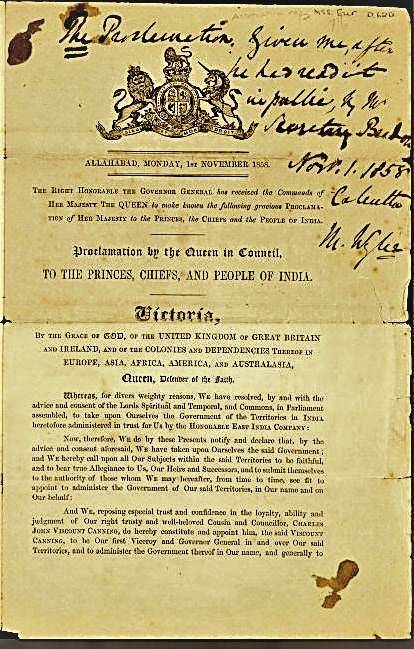
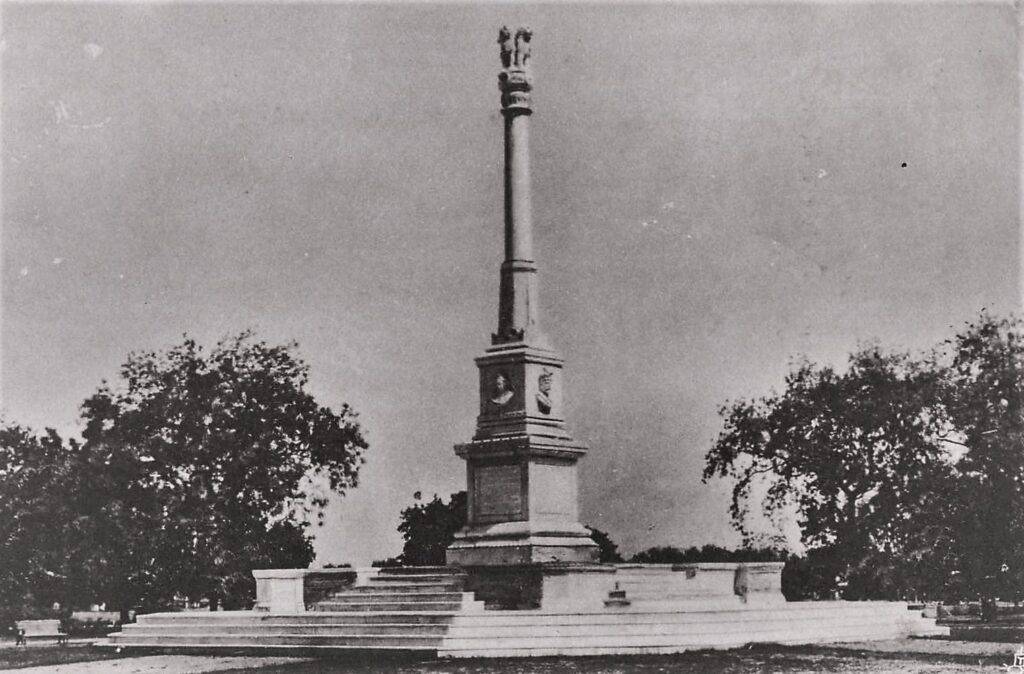
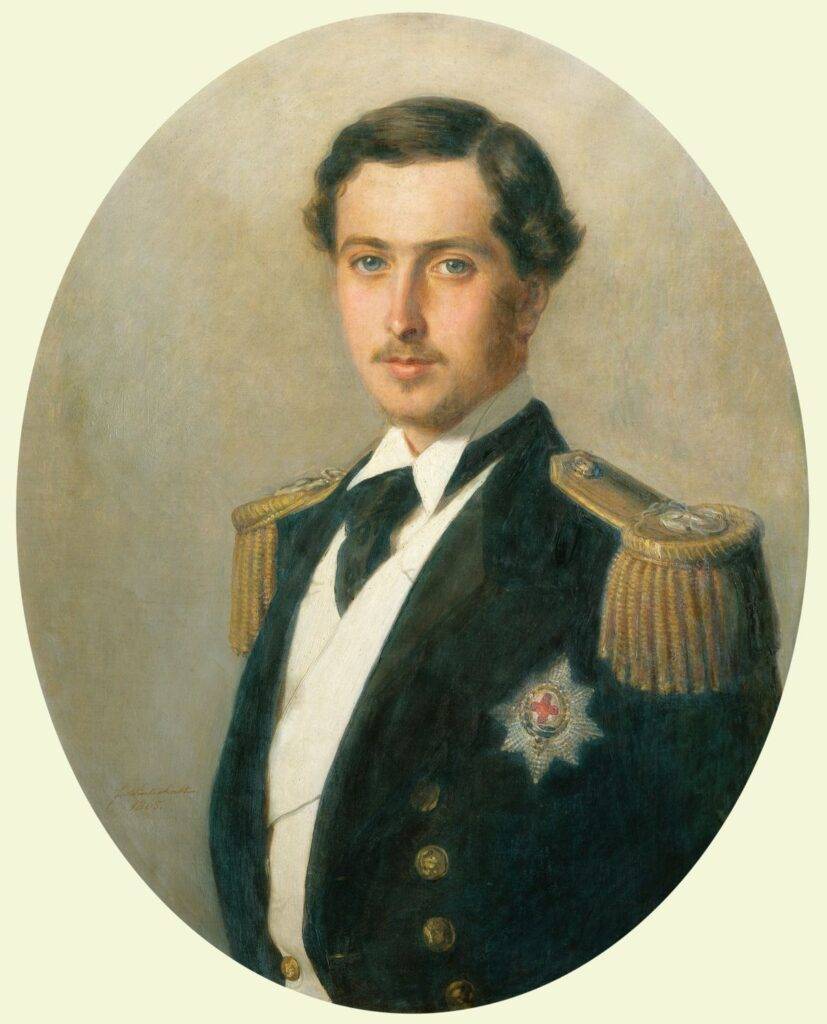

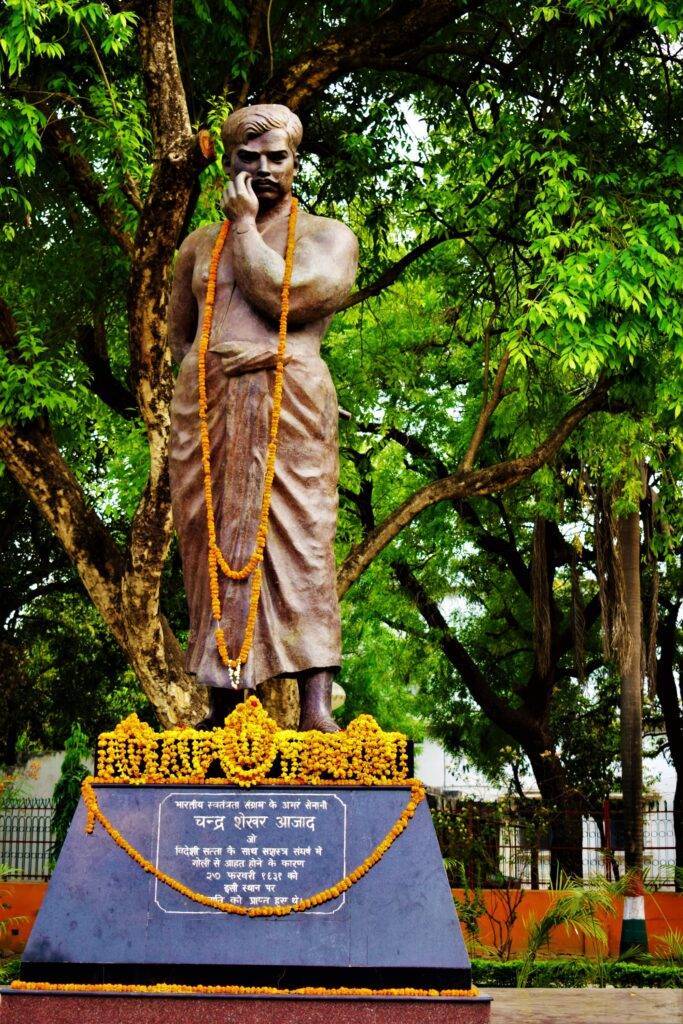





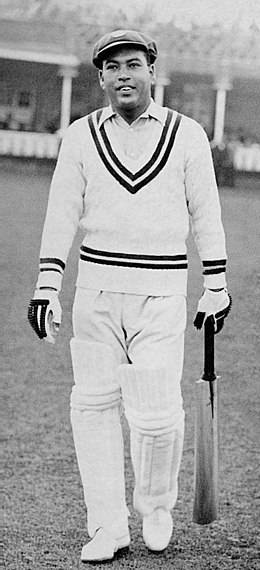
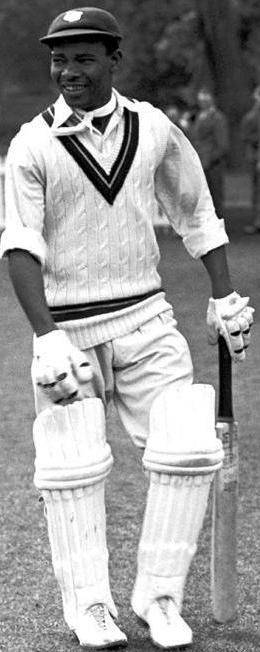

0 Comments